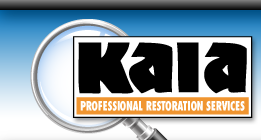MOLD
Our Mold Remediation Process
We at Kala pride ourselves in the simplicity and efficiency of our mold remediation process. When you choose us for your mold remediation needs, the first thing we do is send one of our certified mold remediation experts to your home or business to both assess the extant of the damage to your building and also to identity the source of moisture causing the mold problem.
After we have helped answer your mold remediation questions our first course of action is to ensure that the water or humidity problem causing the mold is eliminated. As mold requires water and/or humidity to grow, eliminating the source of these mold catalysts ensure both that the current mold problem will be stopped, and also that future mold problems will not originate from this same source.
The next step of our mold remediation process is to completely remove all of the mold, and also to dry any water in the water-damaged areas. Our expert mold remediation technicians have access to the leading mold remediation products, which allows them to deal with our customers mold problems on a case-by-case basis. This personalized treatment guarantees that your mold problem will be eliminated, as well as all traces of its presence.
The actual process or removing the mold from your home or business that we use involves covering the affected area form ceiling to floor with polyethylene sheeting with a slit entry and covering flap. We maintain this area by using negative pressure by means of High Efficiency Particulate Air (HEPA) filtered fan unit. We also block all incoming and outgoing air vents connected to the containment area.
After containing the mold problem, we then begin the process of cleaning your building and removing the mold. We remove all moldy porous building materials end double bag the items in 6-mil polyethylene sheeting. Our technicians take extra care in packaging mold contaminated materials before removing them from the containment area to minimize dispersion of mold spores throughout the building during the cleaning process because they know the dangers that mold spores can cause if not carefully contained. If mold spores are not property contained, they can create mycotoxins, or 'fungus poisons.'
Recognizing Mold
Active mold growth is slimy or fuzzy and is usually green, black, orange or purple. Inactive mold is dry and powdery and is usually white. In early stages, mold may look like a web and while in full bloom it looks bushy.
Even when mold is unseen, wet spots, dampness or evidence of water damage will indicate a moisture problem and mold will probably follow.
You can perform a simple test to detect if a suspected spot is moldy. Lightly touch the spot with a drop of household bleach. If the stain loses its color or disappears, it may be mold. If there is no change, it is probably not mold.
Another indicator for mold presence is odor. Mold has a musty, earthy smell that can indicate its presence even if it cannot be seen.


